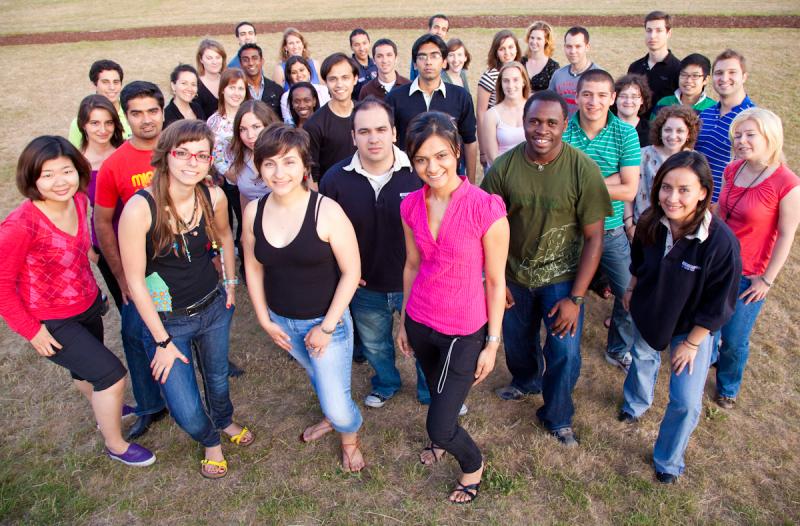In our September 15 entry here at Shareable, we talked about why members of Generation Y—people born after 1980, who have only recently launched their careers—prefer workplaces that are collaborative, non-hierarchical, and networked.
Lots of people do, of course. When we talk to people about the drawbacks of vertical hierarchies—the stifling of creativity, the unhappiness of workers, and the vacuums of communication, etc.—most listeners, young and old, nod their heads.
When we discuss the benefits of a more collaborative, horizontal workplace—increased engagement and satisfaction among workers, more innovation, and less turn-over—again people nod their heads in approval.
However, the idea of a “flat” workplace can sound naively utopian. Some progressive companies do it anyway, but most don’t. Vertical hierarchies have been the organizational norm for companies since the industrial revolution, and the advantages are obvious: they ensure that employees always know their position and tasks within the company, and they know who reports to whom. It is especially effective in larger, assembly-line organizations, where each worker has a specific task to complete in order for the product to be finished by the end of the line.
But from the beginning, the vertical hierarchy had problems. Workers specialized, but they also became disconnected from the final product, interacting only with their one specific step in the production process. This might have worked okay for manufacturing cars, but it’s a liability in the creative, information-based economy. Today, organizations succeed by generating new ideas and utilizing the talents of a highly mobile, educated, networked workforce. Strict vertical hierarchies stop information and ideas in their tracks.
For these reasons, we don’t believe that Gen Y’s desire for a flat workplace is naïve or utopian. Instead, it’s in everyone’s best economic interest. And few people want to dismantle all forms of hierarchy within an organization. Experience matters. So does knowledge and talent.
Our suggestion is more limited: opening up the communication between the rungs on the ladder, creating more of an inter-connected web that facilitates informal as well as formal communication between different levels. The hierarchy is lattice-like, not vertical. It looks like the World Wide Web on which Gen Y was raised.
In networked organizations, hierarchy is shifted from individual decision-making to a more group-oriented way of working and thinking. Sharing, not hoarding, is what generates value—when it comes to information, but also to power. Allowing employees to take risks and make decisions within their area of work, instead of relying exclusively on orders from above, gives greater autonomy to workers and instilling more of a sense of control and larger purpose— which is precisely what Gen Y wants.
In practice, how this is implemented will vary from organization to organization. The important change is the mindset. We suggest the following steps to a flatter workplace:
- Unleash Young Talent: Begin with allowing juniors to sit in on a greater number of meetings. Sitting in doesn’t necessarily mean taking space and talking, it means allowing juniors to listen, to understand the thought processes behind the tasks they are delegated, and, in return, to relate their work to the larger whole.
- Formalize Informal Networks: This suggestion comes from the folks at McKinsey. Instead of forcing professionals who want to work collaboratively to search through poorly connected organizational labyrinths for the knowledge and partners they need, companies should support networks large and small by investing in infrastructure that makes communication and networking easier–for example, through internal social networking sites. At BestBuy, once a stiflingly hierarchical workplace where employee turnover was high and satisfaction low, the implementation of extensive internal social sites that foster company-wide communication as well as forums for the vetting of new ideas from anyone, no matter how low on the corporate ladder, have completely revolutionized and re-energized the company. BestBuy has also instituted a program known as ROWE, for “results-only workplace,” which was actually created by a rogue group of employees that stepped out of “line” in a struggle to eliminate “facetime.”
- Dismantle Cubicle Walls: A big step in “flattening” a workplace may actually be physical: tear down the walls in favor of an open office landscape that is conducive to informal collaboration and information sharing. If you think you need to keep your workers away from each other like rowdy children in a playgroup, then you are having trust issues. Suggestion: base your trust on the work that the employee delivers, not on how or where it was actually completed.
And so, our last bit of advice is to you, dear Gen Y worker: instead of being complacent and adapting to a status quo in which you don’t believe, speak up. Be respectful, and accept that change does not come overnight, but, for the sake of your future career happiness, and that of your peers— speak up.
It’s not easy, but the Gen Y:ers we know who have brought workplace issues up with their employers are glad they did. One woman we interviewed refers to her workplace as “cubicleland,” and a superior (!) once referred to it as “the morgue." Instead of just stewing about it, she decided that she wanted to improve her work experience by gaining skills outside the office through a volunteer opportunity. She asked her boss if she could re-arrange her schedule once a week and was pleasantly surprised by the enthusiastic “Yes!” she received. She says the next step may be to group together with a few interested colleagues to ask for shared workspace, instead of the dreaded cubicles. Why not? Our new mantra should be: “ask and thou may very well receive.”
For more inspiration and ideas about how to improve your work experience, visit online resources like Brazen Careerist, a social networking career management tool for Gen Y, and our own website, The Lattice Group. You might also check out WorldBlu, a Gen Y and X organization that builds workplace democracy. Here's the CEO, Traci Fenton, talking about organizational democracy.









